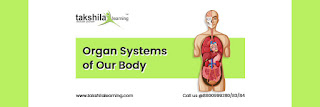Organ Systems of the Human Body Grade 3 Science
A great number of cells make up our body. Tissues refers to a group of cells. Organs and body parts are made up of different types of tissues that come together to form organs or body parts. There are five sensory organs in our body, as well as several additional organs. These organs function together as a team. An organ system is a group of organs that work together to perform one fundamental task for the body. An Organ System is made up of a number of organs that collaborate to perform the same task. In order for our body to operate effectively, these organ systems must work together.Organ Systems
Bones and joints make up the Skeletal System. It supports our bodies and helps us to move about. The skull protects the brain, the rib cage protects the heart and lungs, and the skeleton protects other vital organs.
The Digestive System aids in the digestion of meals. The mouth, food pipe, stomach, intestines, and rectum are the organs of this system. The food is broken down in the stomach.
The Respiratory System assists humans in inhaling and exhaling air. The nose, larynx, wind pipe, and lungs are the organs of this system. Lungs work similarly to balloons in that they can expand and collapse.
The Circulatory System assists us in moving items from one portion of the body to another. The heart, arteries, veins, and blood are all components of this system. The heart functions as a pump, pushing blood into arteries. Arteries are vessels that deliver blood to various regions of the body. The blood is returned to the heart via the veins.
The Excretory System aids in the elimination of waste from the body. Many wastes, as well as sweat, are expelled from the body through the skin. Carbon Dioxide combines with the air we exhale. It's then expelled through the nose.
Know more organ systems of our body

Comments
Post a Comment
Thank you we will contact ASAP.